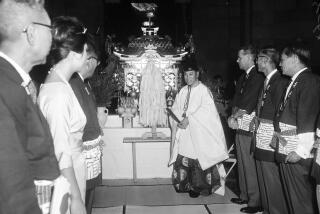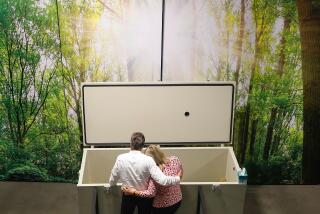Dissecting source of cadavers
- Share via
SACRAMENTO — Cars packed the parking lot of a shuttered CompUSA store one recent weekday afternoon as schoolchildren, health professionals and the just plain curious paid $24 apiece to stare at a score of plasticized, dissected human cadavers and roomfuls of preserved body parts.
The cadavers are displayed dramatically, with layers of skin and muscle peeled back to reveal internal organs, bones, blood vessels and nerves. The exhibition, with bodies posed as if playing a violin, swinging a golf club or performing other tasks, provoked plenty of hushed comments.
“Where do they come from?” a young woman asked a guide dressed in a white lab coat.
“They’re elderly Chinese men who donated their bodies,” the docent said.
Now, California lawmakers are asking similar questions about the traveling exhibits of so-called plastinated bodies. On Thursday the state Assembly voted 50 to 4 to approve legislation to ensure that the people whose remains are on display consented to be gawked at by the public. The bill next goes to the Senate.
“Although plastination was intended to advance medicine and science, many entrepreneurs are using plastination to make outrageous profits by dissecting, mutilating and parading unwilled bodies around the world and in our state,” the bill’s sponsor, Assemblywoman Fiona Ma (D-San Francisco), said during Assembly debate. “Asking for consent and verification is not too much to ask.”
The two major anatomy exhibitors are divided on the legislation. Industry pioneer Body Worlds said it has no problem providing donor documentation. The other exhibitor, Premier Exhibitions Inc., which operates the Sacramento show, said it obtained all the remains legally from Chinese medical and scientific organizations but does not know the identities of the donors.
Ma, a Chinese American, said she became concerned about the use of Chinese remains after viewing a 2005 anatomy exhibition when she served on the San Francisco Board of Supervisors.
“Chinese people are very superstitious about death. If someone dies in a house, they won’t buy the house,” she said. “They believe in full-body burials. They don’t believe in organ donations, and some people don’t even believe in giving blood. So, automatically, I thought that something was wrong with the show.”
She sponsored a successful ordinance requiring exhibitors to provide documentation that bodies had been willfully donated by the people or their next of kin. The ordinance became the basis for the bill in Sacramento.
The bill would require exhibitors to get a county permit; to do so, they would have to prove to county health officials that the people whose cadavers were on display -- or their next of kin -- had consented. Infractions would carry a fine of as much as $10,000.
The legislation targets “a legitimate area for discussion and for public policy,” said Ben Rich, a bioethics expert at the UC Davis Medical School. An exhibitor’s failure to receive informed consent from a donor or next of kin “does not necessarily mean they obtained the bodies in an illicit way,” he said, “but it could be a cause for concern that they did.”
Arnie Geller, the chairman of Atlanta-based Premier, said he is confident he can convince the Legislature that the identities of the bodies in his shows -- called “Bodies Revealed,” “Our Body: The Universe Within” and “Bodies: The Exhibition” -- are known to Chinese authorities.
“All of the bodies and organ specimens” in two of his three shows “came from individuals who chose to donate their bodies to medical science for the purpose of study and education,” Geller said. A third show, he said, uses “unclaimed” bodies. All died from natural causes, he added.
Geller said the proposed legislation is vague and gives too much power to local officials.
“It could, in our opinion, deprive the public from having the opportunity to be educated by these dissected and polymer-preserved specimens,” he said.
Premier said that its 10 traveling human anatomy exhibits have been a major profit center. It reported that nearly 80% of the company’s revenue for the first nine months of last year came from its shows and that the shows’ revenue rose by 121% during that period compared with 2006.
The other major exhibitor, Body Worlds, is a privately held German corporation and does not issue financial filings. Body Worlds’ founder, Gunther von Hagens, said his organization is “prepared to show informed consent by donors for specimens on display” to county public health officials.
Spokeswoman Georgina Gomez said Body Worlds displays its bodies only at established museums and does not use bodies from China.
Body Worlds, which held its first U.S. plastination show at the California Science Center in Los Angeles in 2004, is scheduled to return to the Exposition Park museum in March.
Jeff Rudolph, the center’s chief executive, said he was satisfied with Body Worlds’ donation procedure after having it reviewed by “a very prominent group” of medical and religious ethicists.
“I’m personally quite aware of it because I am a body donor to the exhibit,” he said.
Rudolph said he can’t vouch for the other exhibitor.
“They finesse where the bodies come from,” he said.
Although the ethics of the exhibits worry some lawmakers, they don’t appear to matter to some visitors at the “Bodies Revealed” show in Sacramento.
“Hey, you’re dead. What’s the difference what they do with your body?” asked Dan Rose, a retired Malibu firefighter, who said he doesn’t want the government to regulate such educational exhibits.
--
More to Read
Sign up for Essential California
The most important California stories and recommendations in your inbox every morning.
You may occasionally receive promotional content from the Los Angeles Times.











